 Don’t panic Ubuntu fans but your favorite desktop Linux distribution has fallen to fourth place in DistroWatch’s latest ranking.
Don’t panic Ubuntu fans but your favorite desktop Linux distribution has fallen to fourth place in DistroWatch’s latest ranking.
Ubuntu has been overtaken by Fedora, Mint, and openSUSE. Mint now holds the number one spot in all of DistroWatch’s rankings going back at least a year, which leads us to wonder why.
One reason behind this reversal of fortune for Ubuntu could be the change of default interface in version 11.04 or “Natty Narwhal”, released in April 2011. With the new Ubuntu came Unity, an interface previously seen in Ubuntu Netbook Edition, and Gnome was relegated to an option.
There has been quite a bit of controversy surrounding Unity. Now it seems like Canonical, the company behind Ubuntu, may be paying the price for the change. Let’s look at the numbers.
You can read about some of our favorite command line tools for network administrators here.
Mint’s rise to the top
We charted the top distributions since 2005, as ranked by DistroWatch. In doing so, we excluded a couple of distributions that only made a brief appearance in the top five: Mandriva dropped off after 2006, PCLinuxOS only made an appearance in 2007 and 2008, and Sabayon only showed up during 2007.
Here’s what it looks like from 2005 until now for the current top five Linux distributions:
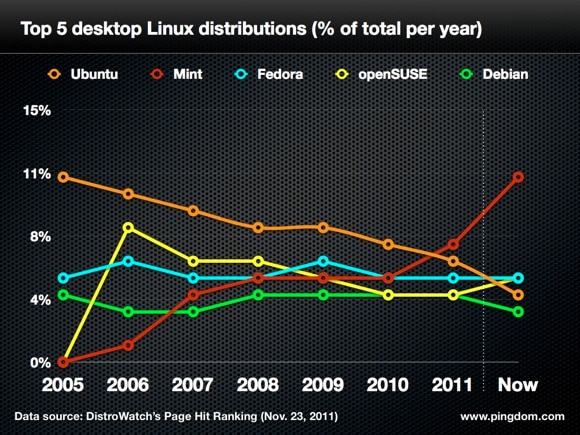
Based on the DistroWatch numbers, Ubuntu’s market share has been declining for years, and has seen a remarkable drop in 2011. Linux Mint, on the other hand, has seen a huge leap in market share this year and has become the most popular desktop distribution. Is this a side effect of the controversy around Unity?
To give you an idea of how drastic the recent changes are, let’s compare the most recent statistics (for the last 30 days) with the average number for 2010:
- Ubuntu is down 47.2%.
- Mint is up 105%.
Note that even though the relative share of Ubuntu has dropped during this period, the total number of hits on the distribution pages at DistroWatch has almost doubled.
Adding that to the mix makes Mint’s popularity even more spectacular.
Comparing the top five: Mint is growing fast
If we focus on the last 12 months, we can see how this compares between the top five distributions: Debian, Fedora, Mint, openSUSE, and Ubuntu. First we see how they compare to the total of all desktop Linux distributions as reported by DistroWatch:
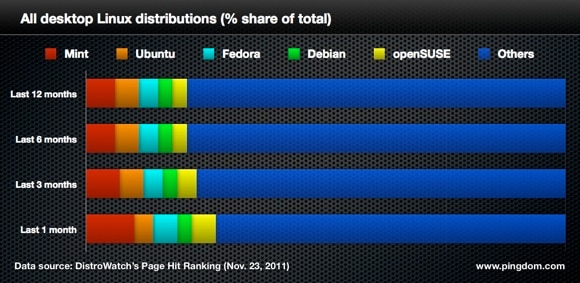
Besides the remarkable growth of Mint, which is again obvious, it’s also interesting to note that the top five distribution’s share of the total has increased quite significantly over the year.
Here are a few highlights:
- Mint’s share of the average hits per day for the specified periods has almost doubled, with an increase from 5.6% to 10.12%.
- Ubuntu has fallen from 5.4% to 3.82%.
- Debian’s popularity has shrunk a bit from 3.42% to 2.95%.
- Fedora has gained from 3.97% to 4.88%.
- openSUSE has also gained some, moving from 3.35% to 4.83%.
- We should also point out that the total has increased during the 12-month period with about 21%, possibly indicating a rising popularity of Linux as a whole.
What we’re comparing here is really the average hits for each distribution over the four periods. As you can see from the first chart, the difference is even more noticeable over a longer period of time.
Then we dig into the relationship between the top five distributions:
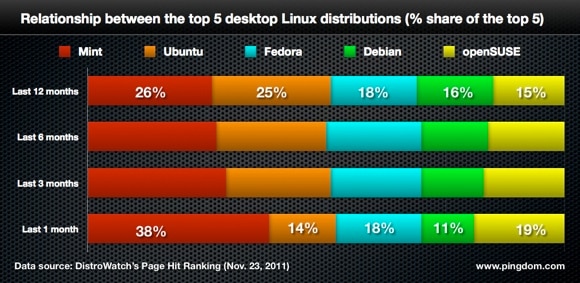
In this chart, a bar represents each distribution’s share out of the total for the top five distributions for the period. It gives you a good overview of how things have shifted in the top five over the last 12 months. Here the change for Mint and Ubuntu is even more clear:
- Mint has gone from 26% of the top five to 38%.
- Ubuntu has lost quite a bit, from 25% down to 14%.
Again it’s clear that Ubuntu is the big loser.
What does Google say?
We have used Google before to review at the state of Linux. So again we turn to Google Trends to chart Linux and to supplement DistroWatch. Since this is based on search statistics, it’s more to gage the “interest in” the various distributions, or mindshare, if you like.
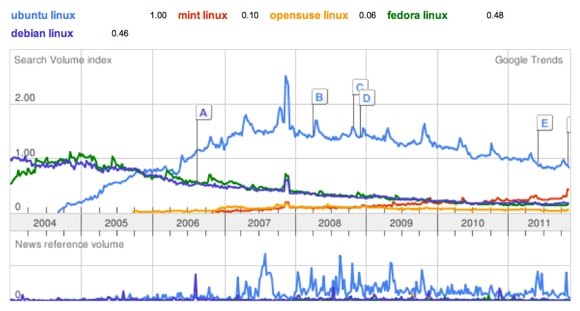
The downward trend for Ubuntu is clear to see also with Google’s tool but the rise of Mint is also visible. Mint is overtaking openSUSE by mid-2008, and Debian and Fedora about 18 months later. Towards the end of the chart, in 2011, there’s a definite spike in search volume for Mint, according to Google Trends.
Time for Ubuntu to take notice
It’s obviously way too early to say whether Ubuntu, in actual use, is declining or not. However, if this is any indication of which way the wind is blowing, it’s time for Ubuntu to take notice.
What we also can’t say for sure based on this research is why this change in popularity is happening. It’s possible that it’s due to how the DistroWatch numbers are put together, and it’s possible that Unity is having some effect.
It does seem certain that the timing of Unity’s introduction coincides with the decline in Ubuntu’s popularity. And according to DistroWatch, the widening of the gap between Mint and Ubuntu is accelerating.
Finally, we have to congratulate the Linux Mint team. They are clearly doing something right with so many Linux users choosing their specific distribution.
Update (2011-11-25)
Some of you asked about what the situation for Ubuntu would look like if we included the other Ubuntu distributions in the statistics, like KUbuntu. We went back to the numbers and here’s the chart with all Ubuntu distributions added into the Ubuntu category:
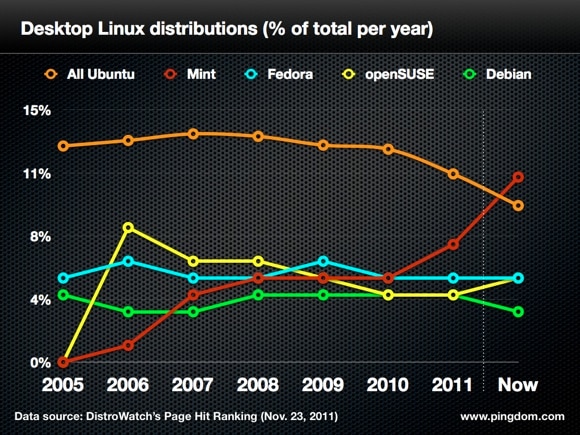
The popularity of Ubuntu increased until about 2007 but then it’s been in decline relative to desktop Linux in entirety. Since 2010, the decline for Ubuntu and the rise for Mint is not much less dramatic.


























